Like Eden’s original garden, your Florida landscape can showcase nature’s most spectacular tropical natives that actually belong here. You’ll discover plants that handle humidity spikes of 90% in summer, survive occasional 28°F winter nights, and bloom through scorching August heat. These aren’t your typical houseplants—they’re evolutionary survivors that’ll transform your yard into a wildlife magnet while requiring half the water of traditional landscaping. But choosing the wrong species means watching your investment wither.
Contents
- 1 Florida’s Unique Subtropical Environment
- 2 Vibrant Wildflowers for Florida
- 3 Shade-Providing Native Trees
- 4 Hardy Shrubs for Coastal Areas
- 5 Selecting the Right Native Plants for Your Garden
- 6 Frequently Asked Questions
- 6.1 How Often Should I Water Newly Planted Florida Native Plants?
- 6.2 What Are the Best Months to Plant Tropical Natives in Florida?
- 6.3 Do Florida Native Plants Require Special Fertilizers or Soil Amendments?
- 6.4 How Do I Protect Native Plants From Hurricanes and Strong Winds?
- 6.5 Can Florida Native Plants Survive Occasional Freezes in Northern Florida?
Florida’s Unique Subtropical Environment
While most of the continental United States battles harsh winters, Florida’s unique subtropical environment creates a year-round paradise for tropical plants. You’ll discover that your state’s 240–280 frost-free days annually provide exceptional growing conditions that most gardeners can only dream about. The USDA Hardiness Zones range from 8B in northern regions to 12A in the Keys, allowing remarkable plant diversity.
Native plant adaptations have evolved specifically for Florida’s wet and dry seasonal patterns, demonstrating impressive climate resilience. Your location benefits from the Gulf Stream’s moderating influence, which reduces temperature extremes and supports tender tropical species year-round. Eastern Florida regions enjoy abundant 2,400 to 2,800 hours of sunshine annually, providing optimal light conditions for photosynthesis and vigorous plant growth.
Vibrant Wildflowers for Florida
Florida’s diverse ecosystems support an extraordinary array of native wildflowers that bloom year-round, offering spectacular colors and textures while requiring minimal maintenance in appropriate habitats. These wildflowers provide crucial support for native pollinators during the lean winter months when other food sources are scarce.
Firebush (Hamelia Patens)
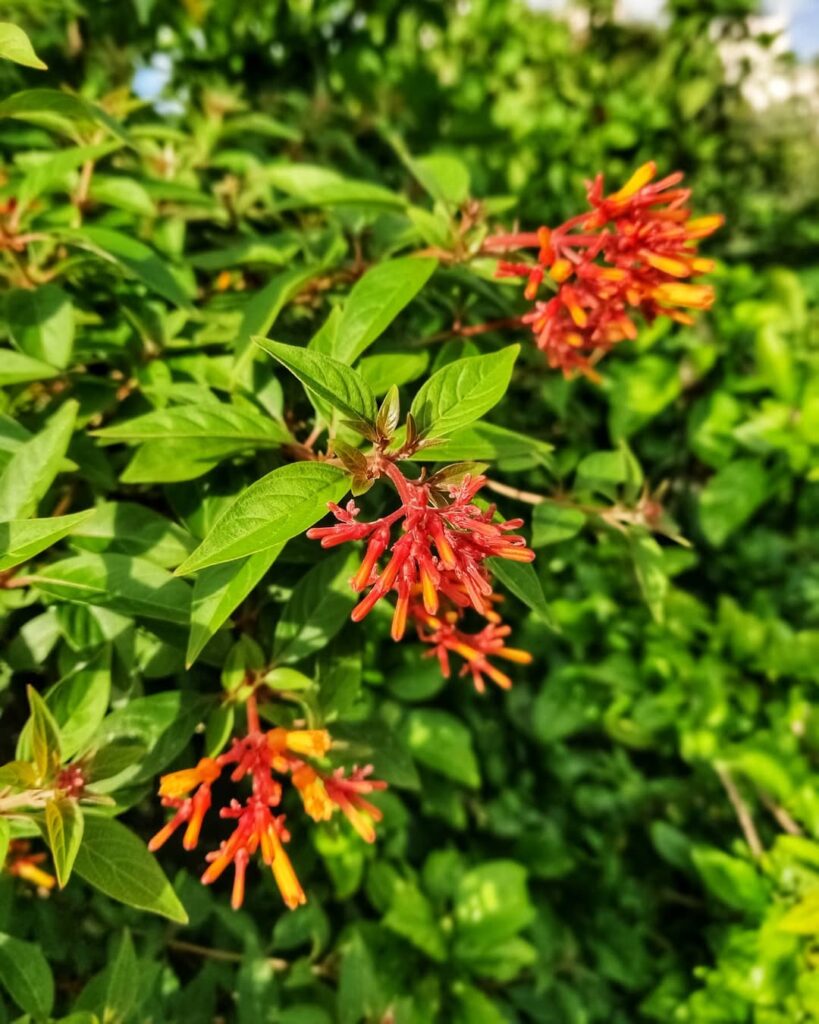
Firebush (Hamelia patens) is a stunning native shrub that brings year-round color to Florida landscapes with its clusters of bright orange to red tubular flowers. This semi-woody perennial reaches 5-15 feet in height and serves as a magnet for hummingbirds, butterflies, and other pollinators. Its extended blooming period from late spring until frost, combined with small dark berries that attract songbirds, makes it an exceptional choice for wildlife gardens and native landscaping.
The plant’s semi-evergreen to evergreen foliage provides structure throughout the year, with new growth often displaying attractive reddish tones. Known by various names including “hummingbird bush” and “scarlet bush,” firebush demonstrates remarkable adaptability across different growing conditions while maintaining its reputation as a low-maintenance, long-lived addition to both formal and informal garden designs. The plant shows moderate tolerance to salt spray, making it suitable for coastal planting areas.
- Hardiness: Root-hardy perennial in North Florida; evergreen in South Florida
- Light: Full sun to partial shade (full sun optimizes flowering)
- Water: Drought tolerant once established
- Soil: Thrives in a range of Florida soils
- Fertilizer: Low maintenance requirements
- Pest/Disease Resistance: Resistant to serious insect or disease problems
- Growth Rate: Fast-growing, long-lived perennial
Blanket Flower (Gaillardia Pulchella)
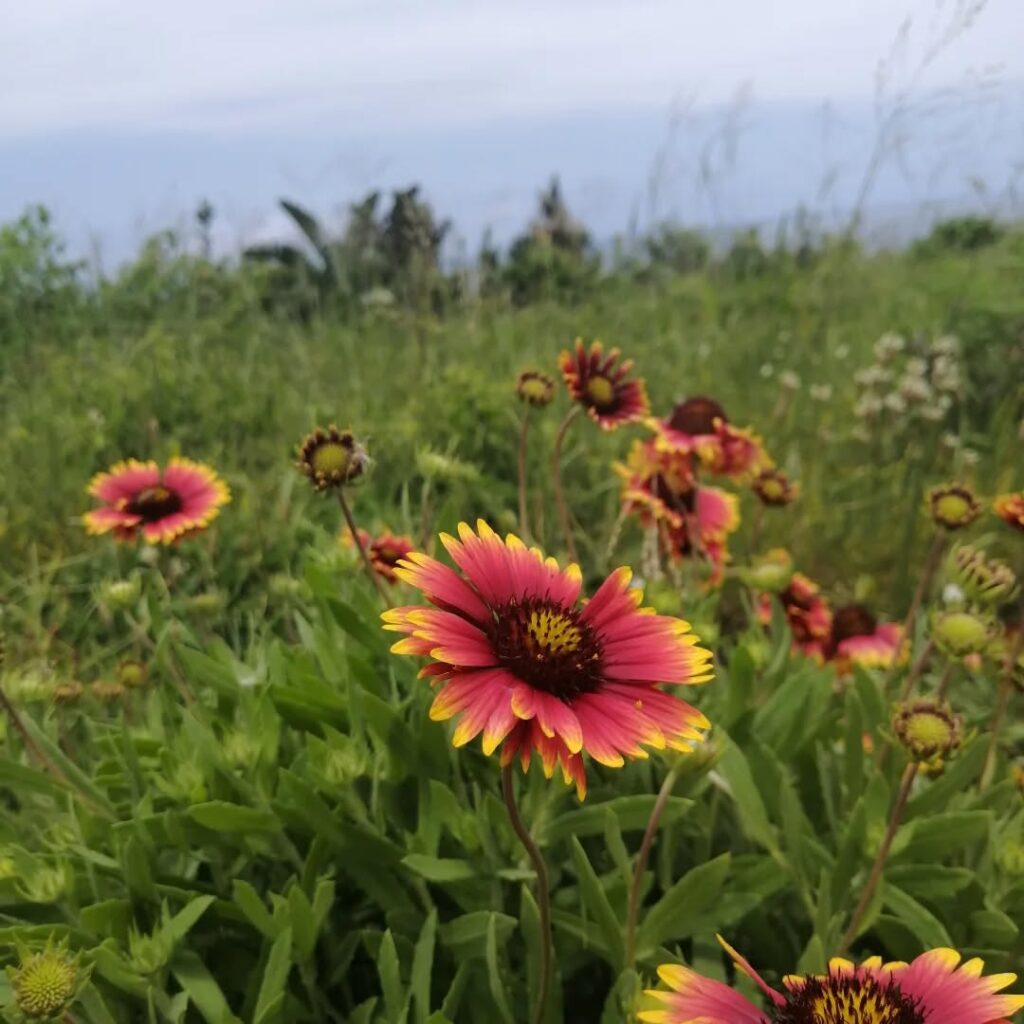
Gaillardia pulchella, commonly known as Blanket Flower or Firewheel, produces vibrant daisy-like blooms with red centers and yellow-tipped petals. While not native to Florida, this hardy wildflower has naturalized throughout the state and forms upright clumps 12-24 inches tall. Its soft, hairy divided leaves remain green year-round in warm climates.
This low-maintenance annual provides months of continuous color and serves as an excellent pollinator plant. The flowers attract butterflies and native bees, while seed heads draw goldfinches and other small birds. Its drought tolerance and minimal care requirements make it ideal for sustainable wildflower gardens, mass plantings, and restoration projects supporting local biodiversity. The plant thrives particularly well in coastal areas, including challenging environments like beach dunes where salt tolerance is essential.
- Hardiness: USDA zones 5a-9b
- Light: Full sun to partial shade (2-6 hours direct sunlight)
- Water: Drought tolerant once established; minimal watering needs
- Soil: Well-drained, sandy soils; pH 6.0-8.0
- Fertilizer: Low fertilizer requirements; minimal feeding needed
- Pest/Disease Resistance: Excellent; occasional aphids and thrips may occur
- Growth Rate: Fast-growing annual with prolific blooming
Coontie (Zamia Integrifolia)
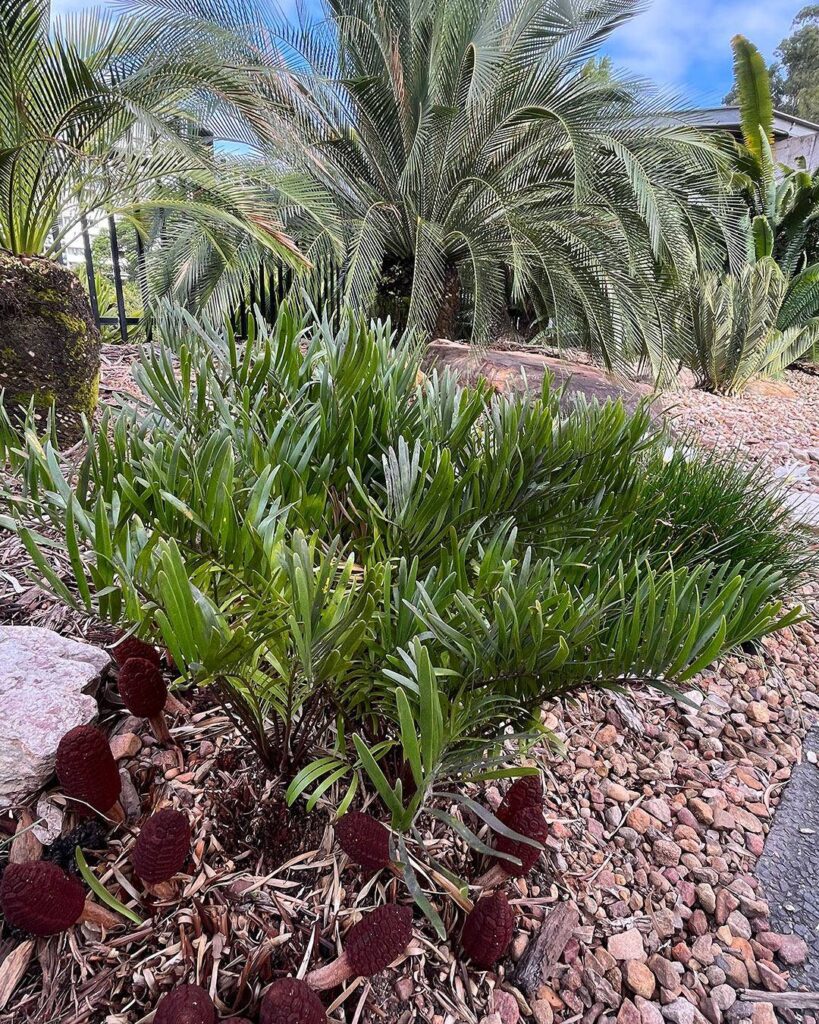
Coontie is Florida’s only native cycad, a primitive plant that produces cones rather than flowers. This small, fernlike plant features glossy, featherlike leaves emerging from an underground stem and typically reaches 1-4 feet in height. Historically used by indigenous peoples for food after careful processing of its starchy roots, coontie earned the common name Florida arrowroot.
As the preferred host plant for the endangered Atala butterfly, coontie plays a significant role in native ecosystem restoration. This slow-growing cycad adapts well to various landscape settings, from specimen plantings to mass groundcover installations. Its ancient lineage predates most flowering plants, making it a unique addition to native Florida gardens that supports local wildlife while requiring minimal maintenance. The plant produces distinctive orange fruits that add visual interest to the landscape.
- Hardiness: USDA zones 8-11, cold hardy and resilient to periodic freezes in Florida
- Light: Full sun to partial shade, adapts to various light conditions
- Water: Highly drought-tolerant once established, requires minimal supplemental watering
- Soil: Well-draining sandy soils preferred, tolerates various soil types with good drainage
- Fertilizer: Low nutrient requirements, benefits from occasional palm fertilizer application
- Pest/Disease Resistance: Generally pest and disease resistant, may attract scale insects
- Growth Rate: Very slow growing, can persist for many decades
Wild Bergamot (Monarda Fistulosa)

Wild Bergamot (Monarda fistulosa) is a striking native perennial wildflower that brings vibrant color and fragrance to Florida gardens. This aromatic plant produces showy clusters of lavender, pink, or white tubular flowers from May through September, creating impressive displays that reach 2-5 feet in height. Its distinctive square stems and minty-scented leaves add both visual and aromatic appeal to the landscape.
More drought-tolerant than other Monarda species, Wild Bergamot forms attractive colonies through shallow rhizomes and serves as an excellent pollinator magnet. The plant attracts bees, butterflies, and hummingbirds while remaining naturally deer resistant, making it a low-maintenance choice for naturalized areas, prairie gardens, and perennial borders. The plant also produces brown nutlets as fruit, which develop after the flowering period and can provide additional wildlife value.
- Hardiness: USDA Zones 3-8, suitable for northern Florida
- Light: Full sun exposure preferred
- Water: Drought tolerant once established, requires less water than other Monarda species
- Soil: Well-drained garden loam, tolerates average prairie-like soils
- Fertilizer: Low maintenance, thrives in average soils without heavy fertilization
- Pest/Disease Resistance: Less susceptible to powdery mildew than Monarda didyma, naturally deer resistant
- Growth Rate: Moderate to fast, spreads 2-3 inches through vigorous rhizomes
Beach Sunflower (Helianthus Debilis)
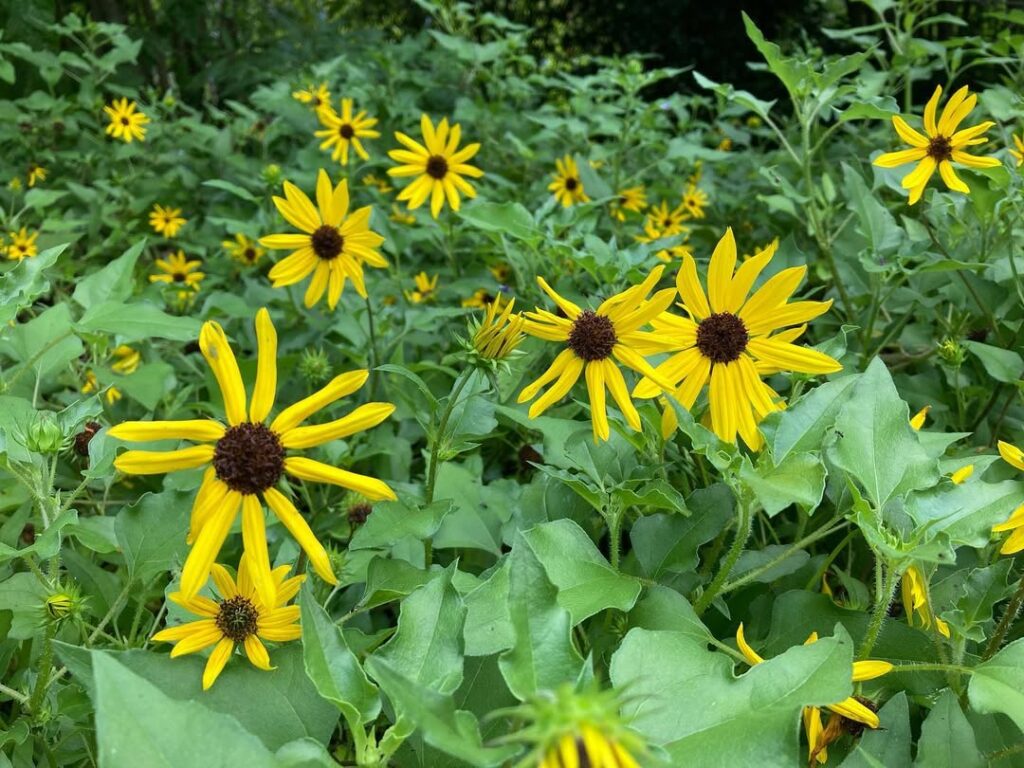
Beach Sunflower (Helianthus debilis) is a vibrant native wildflower that brings year-round color to Florida’s coastal landscapes. This low-growing perennial spreads into dense mats of 2-4 feet in height and width, producing cheerful yellow daisy-like flowers that rise above glossy, dark green foliage on stems reaching up to 6 feet tall.
Exceptionally well-adapted to harsh coastal conditions, Beach Sunflower thrives in sandy, well-drained soils and tolerates salt spray, drought, and strong winds. Its spreading root system makes it invaluable for erosion control and dune stabilization while providing essential habitat for pollinators and birds. The plant features three subspecies found throughout Florida, each adapted to specific coastal regions. This low-maintenance native requires minimal care once established and serves multiple landscape functions from mass plantings to cut flower arrangements.
- Hardiness: USDA zones 8-11
- Light: Full sun
- Water: Low; drought tolerant once established, does not tolerate wet or poorly drained soils
- Soil: Sandy, well-drained soils; tolerates acidic to alkaline pH
- Fertilizer: Minimal requirements; over-fertilization can inhibit flowering
- Pest/Disease Resistance: Excellent; no major pest or disease problems
- Growth Rate: Vigorous spreading growth
Shade-Providing Native Trees
Florida’s native trees offer exceptional shade solutions while supporting local ecosystems. From towering live oaks to adaptable cypresses, these species provide cooling canopies suited to diverse landscape needs and environmental conditions. The majestic Southern magnolia stands out with its fragrant flowers and can reach impressive heights of up to 90 feet.
Bald Cypress (Taxodium Distichum)
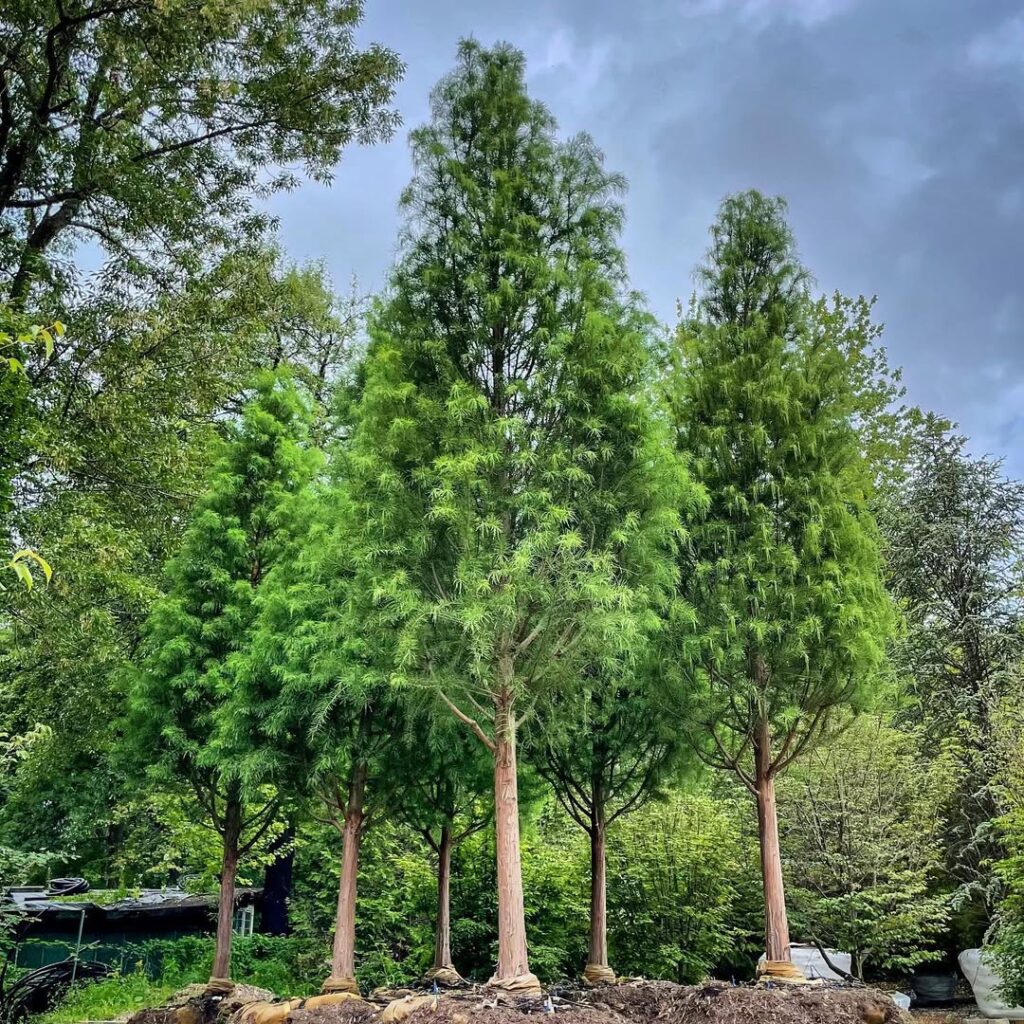
The Bald Cypress is a magnificent deciduous conifer native to southeastern wetlands, capable of reaching 50-75 feet in cultivation and up to 150 feet in natural settings. This adaptable giant transforms from a pyramidal youth to a broad, flat-topped mature specimen, distinguished by its sage-green needles that turn stunning russet-red in fall before dropping.
Notable for its characteristic root “knees” and fibrous, peeling bark, the Bald Cypress serves as Louisiana’s state tree. Its rot-resistant heartwood makes it valuable for construction, while its ecological benefits include erosion control, wildlife habitat, and natural water filtration in wetland environments. The tree exhibits a moderate growth pattern, typically reaching 40 to 50 feet in height within 15 to 25 years.
- Hardiness: USDA zones 4-10, extremely adaptable to various climates
- Light: Full sun to partial shade, versatile in different lighting conditions
- Water: Highly adaptable from saturated wetland conditions to well-drained soils
- Soil: Tolerates wet muck, sandy, loam, and clay soils; prefers acidic pH below 6.8
- Fertilizer: Low maintenance, typically requires minimal supplemental feeding
- Pest/Disease Resistance: Generally resistant to most pests and diseases, very hardy
- Growth Rate: Moderate to fast, establishing quickly in appropriate conditions
Southern Live Oak (Quercus Virginiana)
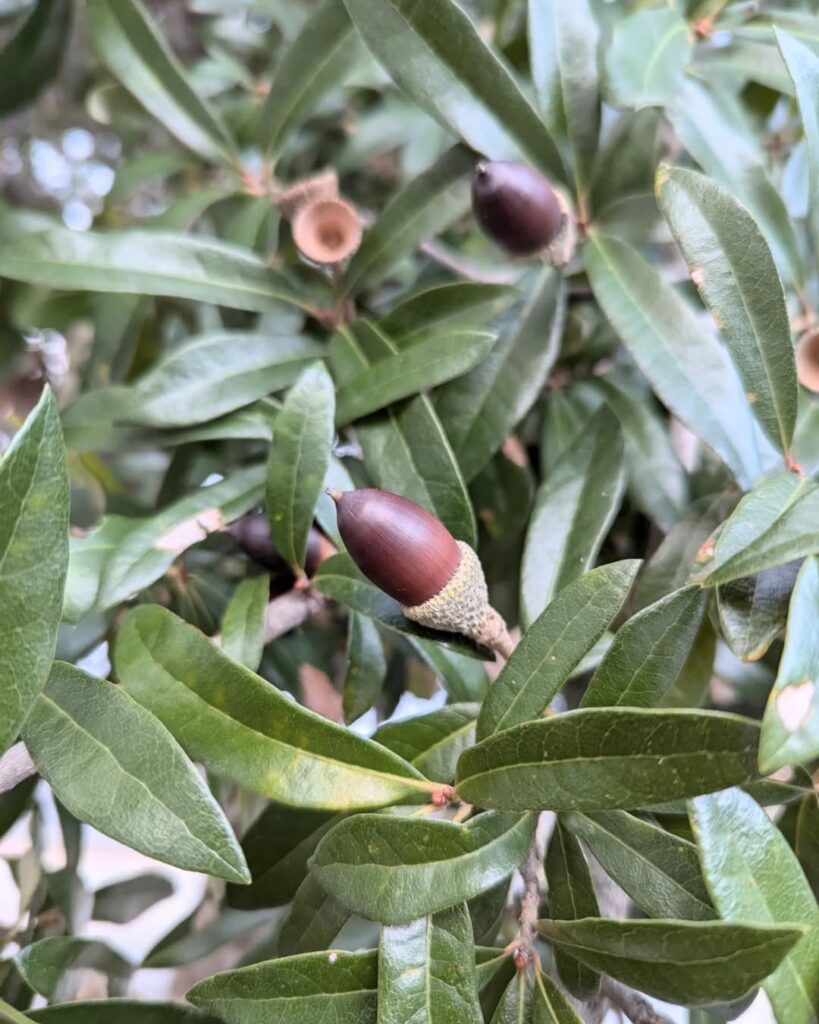
The Southern Live Oak (Quercus virginiana) is a majestic evergreen oak native to the Southeastern United States and northeastern Mexico. This iconic tree is renowned for its distinctive spreading crown that can span up to 150 feet and its characteristically curved, drooping branches that create exceptional shade coverage.
Reaching heights of 60-80 feet with even wider spreads, the Southern Live Oak develops multiple sinuous trunks and a rounded crown. Its bark evolves from reddish-brown when young to gray or black with deep furrows as it matures. The tree’s yellowish-brown wood is exceptionally strong and durable, making it both structurally sound and historically valuable. This remarkable tree can live for centuries when properly cared for and located in suitable conditions.
- Hardiness: USDA zones 7B through 10B
- Light: Full sun to partial shade
- Water: High drought tolerance once established; tolerates occasionally wet soils
- Soil: Adaptable to clay, sand, loam, alkaline, acidic, and well-drained soils; tolerates salty soils
- Fertilizer: Low maintenance; typically does not require regular fertilization
- Pest/Disease Resistance: Generally resistant to pests and diseases; urban tolerant
- Growth Rate: Moderate to slow growth rate
Red Mulberry (Morus Rubra)
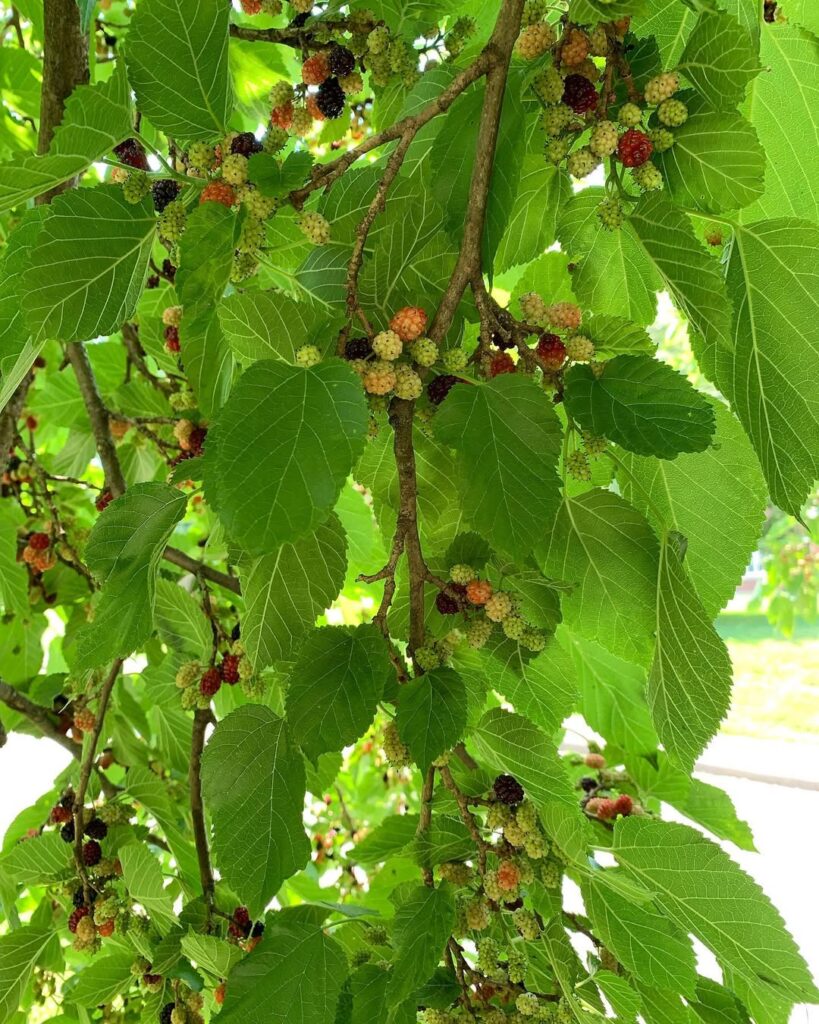
Red Mulberry (Morus rubra) is a fast-growing native tree that typically reaches 40 feet in Florida, offering excellent shade with its broad, rounded crown. This adaptable species produces edible blackberry-like fruits that support 31 bird species and various wildlife. The tree features simple, alternate leaves up to 8 inches long and demonstrates remarkable tolerance to poor soils and drought conditions. Native Americans have historically consumed the fruits, and the species was documented as early as the mid-1500s by European explorers.
While valued for its ecological benefits and shade provision, Red Mulberry requires careful placement due to fruit staining potential. The species can be monoecious or dioecious, with inconspicuous wind-pollinated flowers followed by compound fruit clusters that ripen from green to dark purple, making it an excellent choice for native and edible landscape designs.
- Hardiness: Hardy to subzero temperatures, USDA zones 4-8
- Light: Full sun to light shade
- Water: Moderate; drought tolerant once established, prefers moist conditions
- Soil: Adaptable to infertile sandy soils to rich, moist soils; tolerates poor soil conditions
- Fertilizer: Low requirements; thrives without supplemental fertilization
- Pest/Disease Resistance: Susceptible to leaf spot diseases, witches’ broom, and bacterial diseases
- Growth Rate: Fast-growing with quick establishment
Sweetgum (Liquidambar Styraciflua)

The Sweetgum (Liquidambar styraciflua) is a distinctive native Florida shade tree that grows up to 75 feet tall with a 50-foot spread. This impressive tree features glossy, star-shaped leaves that transform into brilliant shades of red, purple, yellow, and orange during fall and early winter, providing exceptional seasonal interest.
Young sweetgums develop a narrow pyramidal form that matures into a more rounded canopy with attractive arched branches. While native throughout the eastern United States from Connecticut to central Florida and Texas, this long-lived tree thrives in Florida’s climate and serves as an excellent choice for parks, campuses, and large residential properties where ample space allows for its mature size. The tree produces distinctive round, spiny fruit clusters that attract birds but may create cleanup considerations in landscaped areas.
- Hardiness: USDA zones 5-9, well-suited to Florida’s climate
- Light: Full sun; intolerant of shade conditions
- Water: Medium moisture requirements; prefers consistent watering, especially after planting
- Soil: Deep, moist, fertile soils preferred; adapts to various well-drained soil conditions
- Fertilizer: Benefits from regular feeding during establishment period
- Pest/Disease Resistance: Generally resistant with proper care and maintenance
- Growth Rate: Moderate to fast growth rate
Southern Magnolia (Magnolia Grandiflora)
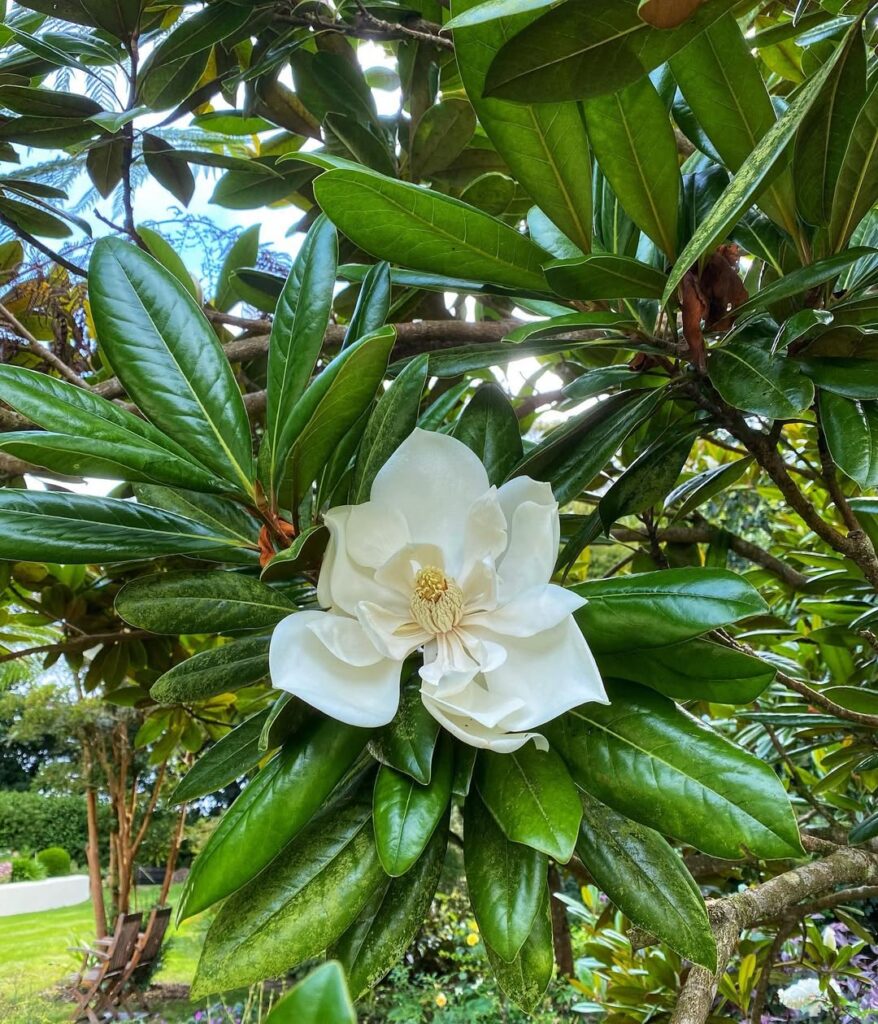
The Southern Magnolia is a majestic evergreen tree native to southeastern United States, including all of Florida. This stately specimen can reach impressive heights of 90-100 feet with a distinctive conical crown and straight trunk. Its dense, leathery dark green foliage provides excellent year-round shade, making it a prized landscape tree for large spaces.
The tree is renowned for its spectacular fragrant white flowers that can reach 6 inches in diameter, blooming against the backdrop of glossy evergreen leaves. As a foundational canopy species, it supports native wildlife through its flowers that attract pollinators and cone-like fruits that feed birds and small mammals. While beautiful and ecologically valuable, it requires ample space due to its eventual size and extensive root system. The roots spread widely, extending up to four times the canopy width.
- Hardiness: Native to warm, humid climates; cold-resistant within native range but seedlings are frost-sensitive
- Light: Full sun to part shade
- Water: Prefers moist conditions but does not tolerate waterlogged soils or prolonged flooding
- Soil: Prefers rich, acidic, well-drained soils; adapts to sandy, loamy, and clay soils
- Fertilizer: Minimal requirements when grown in suitable soil conditions
- Pest/Disease Resistance: Excellent resistance with minimal pest issues
- Growth Rate: Relatively fast-growing
Hardy Shrubs for Coastal Areas
Florida’s coastal environments demand specialized shrubs that withstand salt spray, sandy soils, and strong winds while providing erosion control and wildlife habitat through strategic native plantings. Species like Buttonwood naturally thrive in coastal sites and barrier islands, making them ideal selections for these challenging conditions.
Saw Palmetto (Serenoa Repens)
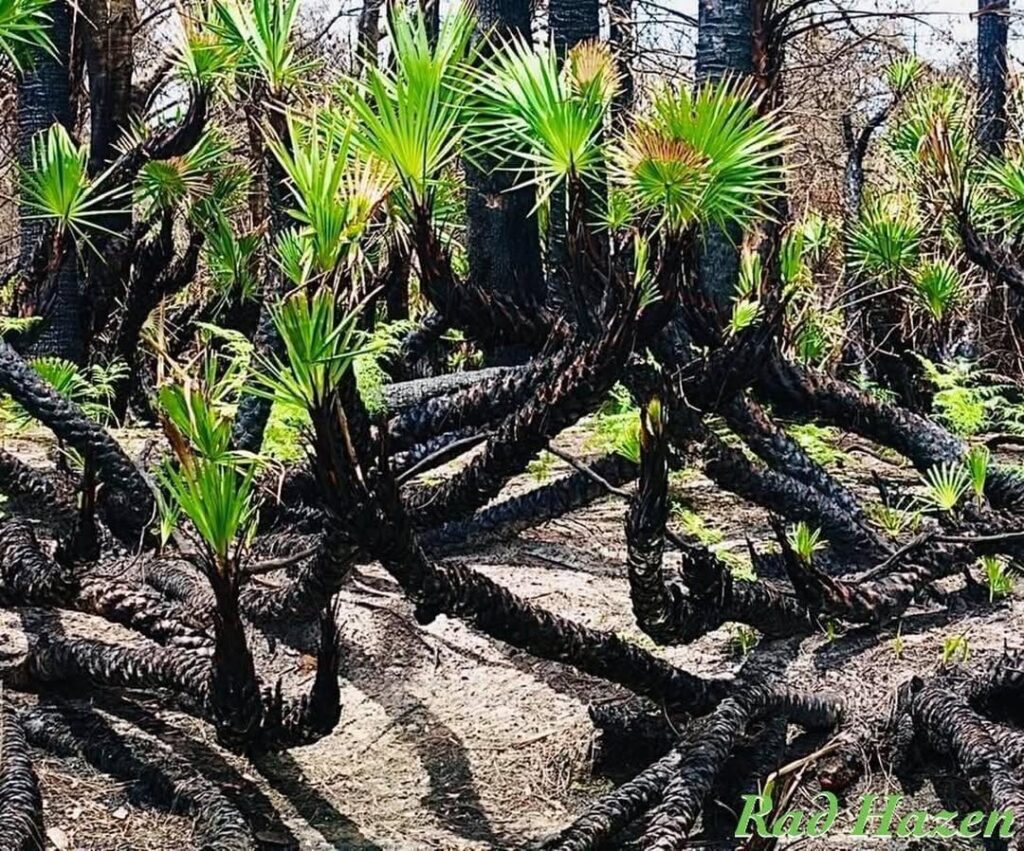
Saw Palmetto is a slow-growing, clumping palm native to Florida’s coastal regions and pine flatwoods. This hardy shrub typically reaches 5-10 feet in height and spreads through underground rhizomes to form dense colonies. Its distinctive fan-shaped leaves feature sharp spines along the stems, and it produces fragrant white flowers followed by dark berries that provide significant wildlife food.
This extremely long-lived palm serves as an essential component of Florida’s native ecosystems, offering habitat for wildlife while helping stabilize sandy soils with its spreading root system. Two varieties exist – green and silver forms – with the plant naturally forming protective thickets in coastal areas and serving as understory vegetation in pine woods and hardwood hammocks. The plant is highly salt-tolerant, making it an excellent choice for oceanfront properties and challenging coastal environments.
- Hardiness: Zones 8-11, extremely cold hardy for a palm
- Light: Part shade to full sun, prefers filtered light
- Water: Moderate to high water needs, drought tolerant once established
- Soil: Well-drained sandy soils, cannot tolerate limestone or high pH
- Fertilizer: Low requirements, benefits from occasional palm fertilizer
- Pest/Disease Resistance: Excellent resistance to most pests and diseases
- Growth Rate: Very slow, may take decades to reach mature size
Wax Myrtle (Myrica Cerifera)
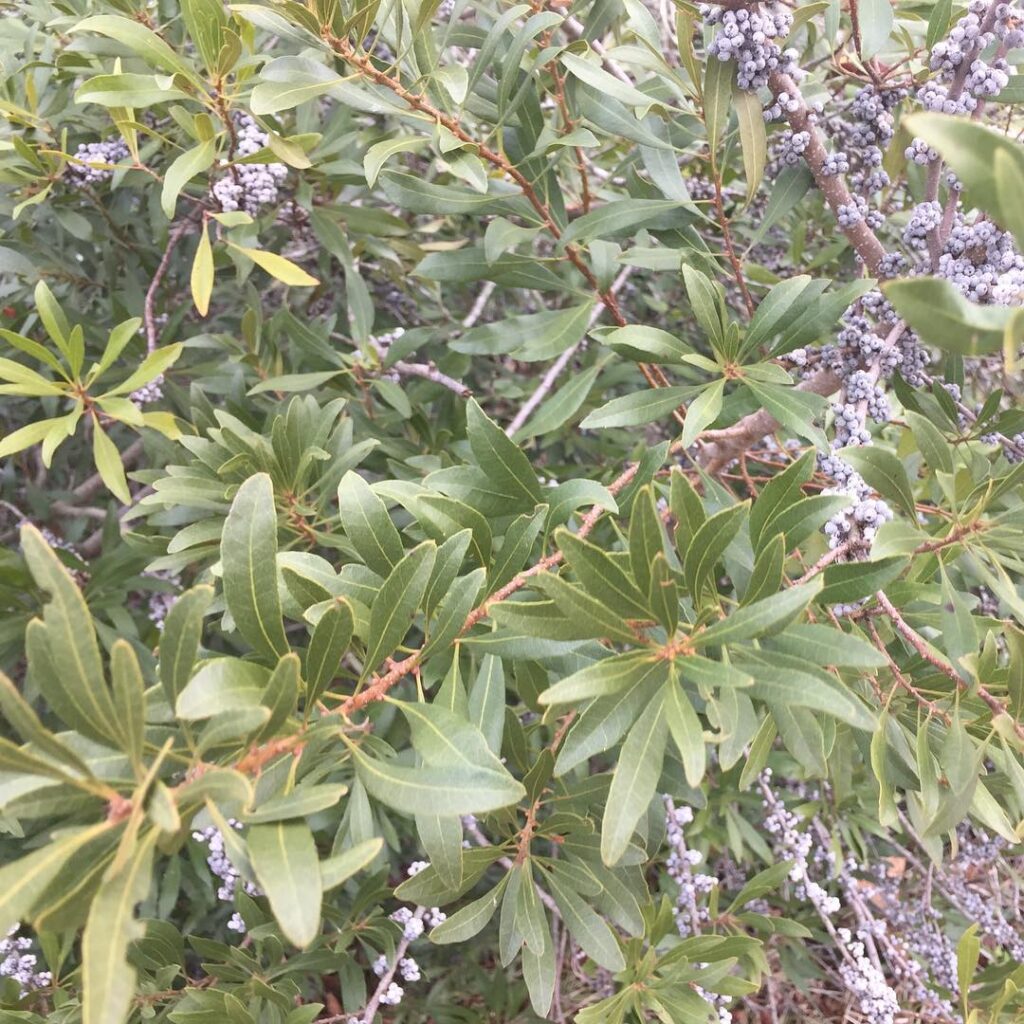
Wax Myrtle is an exceptionally hardy evergreen shrub or small tree that excels in Florida’s challenging coastal conditions. Native to the southeastern United States, this adaptable species can reach up to 40 feet in height and features aromatic, leathery leaves with serrated edges. Female plants produce distinctive pale blue, wax-coated berries that historically provided material for candle-making.
This nitrogen-fixing plant offers tremendous ecological value, providing wildlife food and shelter while enhancing soil fertility. Its dense, clonal growth pattern makes it excellent for hedges, screens, and erosion control. The attractive gray-green foliage remains year-round, and its rapid growth from root sprouts and underground runners guarantees quick establishment in coastal landscapes. The waxy berries serve as an excellent wildlife attractor, particularly drawing birds to the landscape throughout the year.
- Hardiness: USDA zones 7-11, highly tolerant of salt spray and coastal storms
- Light: Full sun to partial shade
- Water: Drought tolerant once established, adapts to both wet and dry soils
- Soil: Tolerates wide range from sandy to rich, moist soils; pH adaptable
- Fertilizer: Low requirements due to nitrogen-fixing capability
- Pest/Disease Resistance: Highly resilient with few serious issues
- Growth Rate: Fast-growing through root sprouting and underground runners
Beautyberry (Callicarpa Americana)
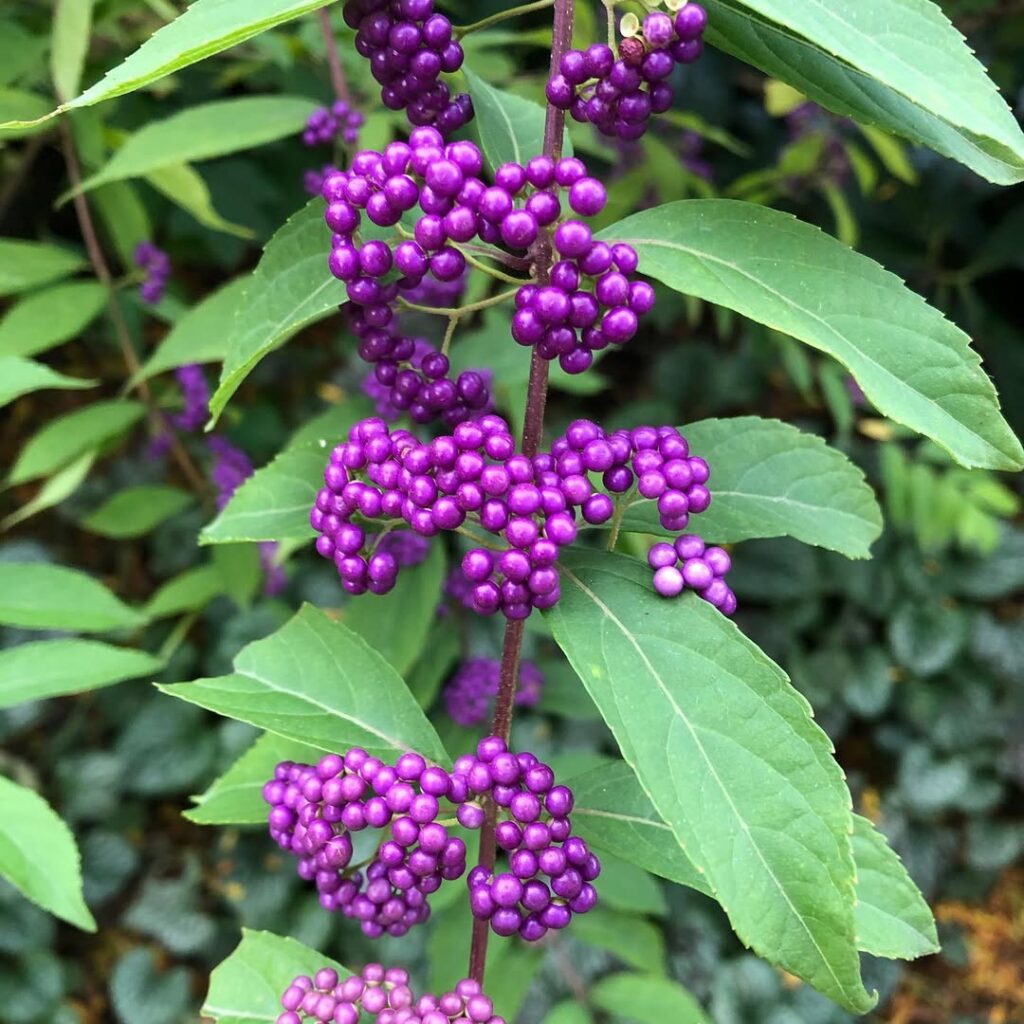
Beautyberry (Callicarpa americana) is a versatile native shrub prized for its stunning clusters of iridescent purple berries that persist through fall and winter. This hardy coastal plant features aromatic leaves and small pink to white flowers that attract pollinators in late spring. Beyond its ornamental value, beautyberry provides essential wildlife habitat and food sources while offering practical benefits like natural mosquito repellent properties from crushed leaves.
Growing 3-8 feet tall and wide with gracefully arching branches, beautyberry adapts well to Florida’s coastal environments. Its loose, sprawling form and minimal maintenance requirements make it ideal for borders, mass plantings, or specimen use in native and pollinator-friendly gardens. The coarse, fuzzy leaves are light green and deciduous, providing textural interest throughout the growing season.
- Hardiness: Thrives in Florida’s coastal and inland environments; foliage evergreen in South Florida, deciduous in cooler areas
- Light: Full sun to partial shade; flowering and fruit production more abundant in full sun
- Water: Tolerates dry to moist conditions once established; drought tolerant
- Soil: Adapts to various soil types; prefers well-drained conditions
- Fertilizer: Minimal fertilizer needs; thrives in native soil conditions
- Pest/Disease Resistance: Generally pest and disease resistant with good air circulation
- Growth Rate: Moderate growth rate; long-lived perennial shrub
Firebush (Hamelia Patens)

Firebush (Hamelia patens) is an excellent choice for hardy coastal plantings in Florida, demonstrating remarkable resilience to wind and salt spray. This semi-woody perennial shrub reaches 8-15 feet in South Florida, producing vibrant orange-red tubular flowers nearly year-round that attract hummingbirds and butterflies. The plant offers multi-seasonal interest with colorful berries evolving from amber to red to black, plus bronze-tinted foliage during cooler months.
As a fast-growing, low-maintenance native, firebush thrives in Florida’s warm climate and adapts well to various coastal and inland conditions. Its drought tolerance once established, combined with no serious pest or disease issues, makes it ideal for screening, hedges, or specimen plantings in wildlife gardens and naturalized landscapes. The plant serves as a larval host for the pluto sphinx moth, adding to its ecological value in native landscapes.
- Hardiness: Semi-evergreen in South Florida; may experience die-back after freezes in North Florida but resprouts in spring
- Light: Shade to full sun; most vibrant flowering and color in partial to full sun
- Water: Drought-tolerant once established; moderate water needs during establishment
- Soil: Adaptable to various soil types; tolerates both coastal and inland soil conditions
- Fertilizer: Low fertilizer requirements; benefits from occasional feeding during growing season
- Pest/Disease Resistance: Excellent; no serious insect or disease problems reported in typical landscapes
- Growth Rate: Fast-growing; effective for quick landscape establishment and screening
Coral Honeysuckle (Lonicera Sempervirens)

Coral Honeysuckle is a native woody vine that produces stunning trumpet-shaped coral-red flowers in clusters. This fast-growing climber reaches 10-20 feet tall and serves as an excellent alternative to invasive honeysuckle species. Semi-evergreen in most of Florida, it provides year-round interest while supporting local wildlife.
This versatile vine thrives in coastal areas due to its moderate salt tolerance and adapts well to Florida’s varying climate conditions. It’s particularly valued for attracting hummingbirds and butterflies, making it an ideal choice for wildlife gardens and naturalistic landscapes. The vine also produces berries that attract songbirds during late summer and fall months.
- Hardiness: USDA zones 4-10a, suitable for all of Florida
- Light: Full sun to part shade; full sun preferred for best flowering
- Water: Moderate water needs; regular watering until established, then moderate drought tolerance
- Soil: Moist, well-drained loamy soil; pH 6.0-8.0; adapts to most soil types except dry sands
- Fertilizer: Not specified in provided information
- Pest/Disease Resistance: Resistant to most pests and diseases; occasionally affected by aphids
- Growth Rate: Fast-growing
Selecting the Right Native Plants for Your Garden
When you’re choosing native plants for your Florida garden, your success depends on understanding three key factors: your location’s hardiness zone, your site’s specific growing conditions, and your landscaping goals.
Florida’s zones range from 8a in the north to 11 in the south, dramatically affecting plant selection. Consider these essential steps:
- Test your soil’s pH and drainage needs before adding soil amendments
- Evaluate sunlight patterns throughout your yard during different seasons
- Research plant companioning to create beneficial growing relationships
- Identify your primary goals: wildlife habitat, erosion control, or privacy screening
Proper planning reduces maintenance requirements while maximizing your garden’s ecological benefits. Native plant nurseries typically carry over 70 Florida native wildflowers, shrubs, vines, and grasses suitable for home landscapes.
Frequently Asked Questions
How Often Should I Water Newly Planted Florida Native Plants?
You should water newly planted Florida native plants daily for the first two weeks to maintain proper soil moisture. Your watering frequency should then gradually decrease as roots establish and plants adapt to their environment.
What Are the Best Months to Plant Tropical Natives in Florida?
Want ideal growth for your tropical natives? The best planting months are May through June, considering seasonal considerations like warm soil temperatures, increased rainfall, and reduced frost risk for successful establishment.
Do Florida Native Plants Require Special Fertilizers or Soil Amendments?
Florida’s native plant care doesn’t require special fertilizers since they’ve adapted to nutrient-poor soils. You’ll improve soil health by adding organic matter and using slow-release fertilizers sparingly during growing seasons.
How Do I Protect Native Plants From Hurricanes and Strong Winds?
Don’t put all your eggs in one basket—diversify your hurricane preparedness strategy by planting deep-rooted natives like live oak and sabal palm for superior wind resistance, then surround them with protective shrub buffers.
Can Florida Native Plants Survive Occasional Freezes in Northern Florida?
You’ll find many Florida native plants have excellent freeze tolerance for northern climate conditions. Cold-hardy natives like Crinum, collards, and certain palms can withstand temperatures down to 10-15°F without protection.
